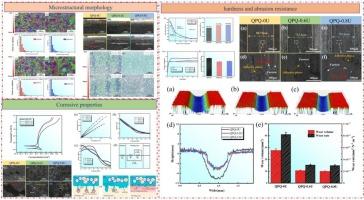QPQ耦合超声轧制后处理工艺强化机理研究
IF 6.1
2区 材料科学
Q1 MATERIALS SCIENCE, COATINGS & FILMS
引用次数: 0
摘要
研究了超声表面轧制工艺(USRP)对淬火-抛光-淬火(QPQ)氮化32Cr3MoVE钢的影响。采用USRP消除了qpq -氮化层的多孔结构,提高了材料的整体性能。结果表明:USRP消除了qpq -氮化层中气孔等缺陷,减小了晶粒尺寸;此外,USRP不仅增加了低角度晶界的比例,而且由于其加工硬化效应,在样品表面引入了深度为250 μm的残余应力场。结果,USRP将氮化层的表面硬度提高了约22%,并将磨损率降低了64%。USRP对材料的作用——消除松散的层间结构和引入压应力——改变了材料的腐蚀机制,提高了材料的耐蚀性。此外,USRP的强化效果随外加静压的增加而增强。本文章由计算机程序翻译,如有差异,请以英文原文为准。

Research on the strengthening mechanism of QPQ coupled ultrasonic rolling post-treatment process
This study investigated the effects of ultrasonic surface rolling processing (USRP) on quench–polish–quench (QPQ)-nitrided 32Cr3MoVE steel. USRP was employed to eliminate the porous structure of the QPQ-nitrided layer and enhance the overall material performance. The results indicate that USRP eliminated defects such as pores in the QPQ-nitrided layer and reduced grain size. Furthermore, USRP not only increased the proportion of low-angle grain boundaries but also introduced a residual stress field with a depth of 250 μm at the surface of the sample owing to its work-hardening effect. As a result, USRP improved the surface hardness of the nitrided layer by approximately 22 % and reduced the wear rate by up to 64 %. The effects of USRP on the material—elimination of the loose interlayer structure and introduction of compressive stress—changed the corrosion mechanism of the material, enhancing its corrosion resistance. Additionally, the strengthening effect of USRP increased with increasing applied static pressure.
求助全文
通过发布文献求助,成功后即可免费获取论文全文。
去求助
来源期刊

Surface & Coatings Technology
工程技术-材料科学:膜
CiteScore
10.00
自引率
11.10%
发文量
921
审稿时长
19 days
期刊介绍:
Surface and Coatings Technology is an international archival journal publishing scientific papers on significant developments in surface and interface engineering to modify and improve the surface properties of materials for protection in demanding contact conditions or aggressive environments, or for enhanced functional performance. Contributions range from original scientific articles concerned with fundamental and applied aspects of research or direct applications of metallic, inorganic, organic and composite coatings, to invited reviews of current technology in specific areas. Papers submitted to this journal are expected to be in line with the following aspects in processes, and properties/performance:
A. Processes: Physical and chemical vapour deposition techniques, thermal and plasma spraying, surface modification by directed energy techniques such as ion, electron and laser beams, thermo-chemical treatment, wet chemical and electrochemical processes such as plating, sol-gel coating, anodization, plasma electrolytic oxidation, etc., but excluding painting.
B. Properties/performance: friction performance, wear resistance (e.g., abrasion, erosion, fretting, etc), corrosion and oxidation resistance, thermal protection, diffusion resistance, hydrophilicity/hydrophobicity, and properties relevant to smart materials behaviour and enhanced multifunctional performance for environmental, energy and medical applications, but excluding device aspects.
 求助内容:
求助内容: 应助结果提醒方式:
应助结果提醒方式:


